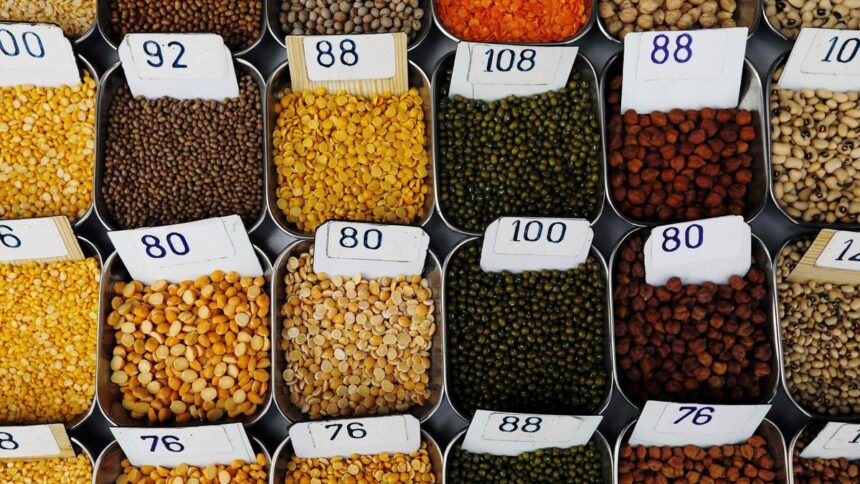Prices for major pulses in the global market have reached record lows, driven by stiff competition among Canada, Australia, Russia, and several African nations vying for market share. Over the past month, prices have decreased between 5% and 20% due to favorable harvest conditions for peas and lentils in these countries.
Trade analysts have expressed concern that this trend might negatively impact Indian farmers, who are currently in the process of harvesting their crops. Key crops such as urad (black matpe), tur (pigeon peas), masur (red lentils), and moth dal (green lentils) have reportedly suffered from torrential rains in August and September across various regions in India.
“Prices for all imported pulses are at unprecedented lows. There’s barely any distinction in the rates from countries like Canada, Australia, and Russia. Notably, yellow pea prices are at a historic low,” said a trader who wished to remain anonymous.
Huge Lentils Surplus
Analysts anticipate a significant surplus of lentils. According to forecasts for the 2025-26 marketing season (August-July), Canada has seen a 9% increase in the area planted with dry peas, amounting to 1.42 million hectares. Yellow pea production is expected to reach 3.2 million tonnes, while green peas are forecasted at 550,000 tonnes, allowing Canada to potentially export over 2 million tonnes of peas.
Canada’s chickpea crop is also projected to be robust, exceeding 340,000 tonnes, with exports likely hitting a record high of 235,000 tonnes. In Australia, chickpea production is estimated at 2.1 million tonnes, a 7% decline from last year.
The outlook for lentils appears similarly positive, with Australia forecasting a 34% increase in production to a record 1.7 million tonnes for the 2025-26 season, greatly exceeding the 10-year average.
Statistics Canada indicates that Canada’s lentil production is projected at 2.75 million tonnes, marking a 12-year high based on current yield estimates.
Other Competitors
Additionally, pulses from the US, Russia, Tanzania, Malawi, Mozambique, Myanmar, and Brazil are anticipated to flood the global market. Among these crops, urad has shown a stable trend, as Myanmar is depleting its inventories from a bumper crop harvested earlier this year, while India’s urad crop is expected to be compromised in key agricultural areas including Madhya Pradesh, Maharashtra, and Uttar Pradesh.
Data from the Global Pulse Confederation (GPC) reveals that only urad prices remain steady at $870 (₹77,240) per tonne for superior quality from Myanmar, and $900 (₹80,000) from Brazil. These prices have remained consistent over the past month.
Landed prices for most pulses, except urad, are below the minimum support prices, as confirmed by GPC and Agmarknet data from the Indian Agriculture Ministry. Currently, domestic prices for tur, urad, masur, yellow peas, and chana are lower than the landed rates for imports.
Masoor Prices Decline
Tur prices have dropped 5% in the past month, with Myanmar offering the pulse at $690 (₹61,240) per tonne. African nations, including Tanzania, Mozambique, and Malawi, have entered the market with competitive offers of $520 (₹46,150), $540 (₹47,940), and $510 (₹45,275), respectively.
Masoor prices have also seen a significant decline, with Canada reducing its offer rates by 16% and Australia by 18%. Currently, consignments from Canada are priced at $540 (₹47,925), while those from Australia are at $530 (₹47,050).
Chana prices have plummeted by 20% over the last month, falling from $690 to $545 (₹48,730) in Australia. Yellow pea prices have similarly dropped by 16% from Canada and 10% from Russia and Ukraine, with Canadian yellow peas priced at $335 (₹29,740) per tonne and those from Russia and Ukraine at $340 (₹30,185).
For moath (green lentils), Canada has reduced prices by 17% and Russia by 18% since August 20, with Canada now selling the pulse at $640 (₹56,820) down from $830 in late July. Russia has adjusted its offers to $645 (₹57,260) from $765 in mid-August.
Duty-Free Imports
Although India does not import green peas, prices for that commodity have fallen by 15% in the last month, with Canadian offers to China decreasing from $475 to $405 per tonne.
Traders have pointed out that the decline in yellow pea prices, nearing $300 per tonne, is alarming, as these imports alone have depressed the pulses market since July 2024. “India imported over 1 million tonnes in the previous fiscal year, and duty-free imports are not alleviating the situation,” noted a trade analyst.
Imports of tur and urad also benefit from duty-free status, extending until March 31, 2026. However, a 10% Customs duty has been imposed on masur and chana imports.
Published on September 25, 2025










